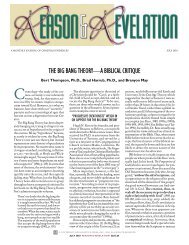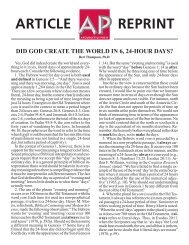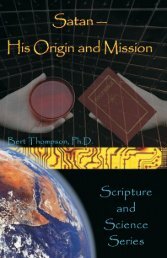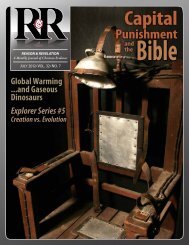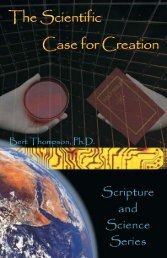The Many Faces, and Causes, of Unbelief - Apologetics Press
The Many Faces, and Causes, of Unbelief - Apologetics Press
The Many Faces, and Causes, of Unbelief - Apologetics Press
Create successful ePaper yourself
Turn your PDF publications into a flip-book with our unique Google optimized e-Paper software.
cur. <strong>The</strong> treatise went on to suggest that historical testimony<br />
regarding miracles is specious, <strong>and</strong> never could be strong<br />
enough to override more important scientific considerations.<br />
For Hume, there was no evidence strong enough to prove<br />
that miracles actually had taken place. His attack upon biblical<br />
miracles had serious consequences upon religion generally,<br />
<strong>and</strong> Christianity specifically. Even today, many refuse to<br />
believe in God because <strong>of</strong> David Hume’s arguments.<br />
One <strong>of</strong> Christianity’s most ardent opponents in the 1800s<br />
was Joseph Ernest Renan. Born in 1823, he was a French historian<br />
who rejected any supernatural content in religion. In<br />
1860, he wrote <strong>The</strong> Life <strong>of</strong> Jesus, in which he repudiated all supernatural<br />
elements in Christ’s life <strong>and</strong> ministry. <strong>The</strong> book<br />
was a frontal assault upon the personal deity <strong>of</strong> Christ <strong>and</strong> received<br />
much attention throughout Europe, assuring Renan<br />
<strong>of</strong> instant fame. He subsequently authored a book on the apostle<br />
Paul, <strong>and</strong> a five-volume set on the history <strong>of</strong> Israel. Today,<br />
his place in history as an infidel has been sealed as a result <strong>of</strong><br />
his strident attacks upon Jesus.<br />
In more recent times, one <strong>of</strong> the most vicious attacks upon<br />
God, Christ, <strong>and</strong> the Bible was spearheaded by Robert Ingersoll.<br />
Born in Dresden, New York, in 1833, he set up his law<br />
practice in Peoria, Illinois, in 1858, <strong>and</strong> eventually was appointed<br />
as that state’s Attorney General. Madalyn Murray<br />
O’Hair, while still director <strong>of</strong> American Atheists in Austin,<br />
Texas, once characterized Ingersoll as “...a superb egotist. And,<br />
he engaged in more than one drunken public brawl.... Not<br />
withst<strong>and</strong>ing all <strong>of</strong> the anomalies <strong>of</strong> his character, he was magnificent<br />
when he did get going on either religion or the church...”<br />
(1983, p. vi).<br />
In <strong>The</strong> Atheist Syndrome, John Koster has suggested concerning<br />
Ingersoll that “what he hated was organized religion” (1989,<br />
p. 123). Shortly after Ingersoll went on the lecture circuit<br />
around 1877, he began to include in his repertoire such topics<br />
as “Heretics <strong>and</strong> Heresies” <strong>and</strong> “Ghosts”—both <strong>of</strong> which<br />
were undisguised attacks upon religion generally, <strong>and</strong> Christianity<br />
specifically. By 1878, he had exp<strong>and</strong>ed his lectures to<br />
-26




